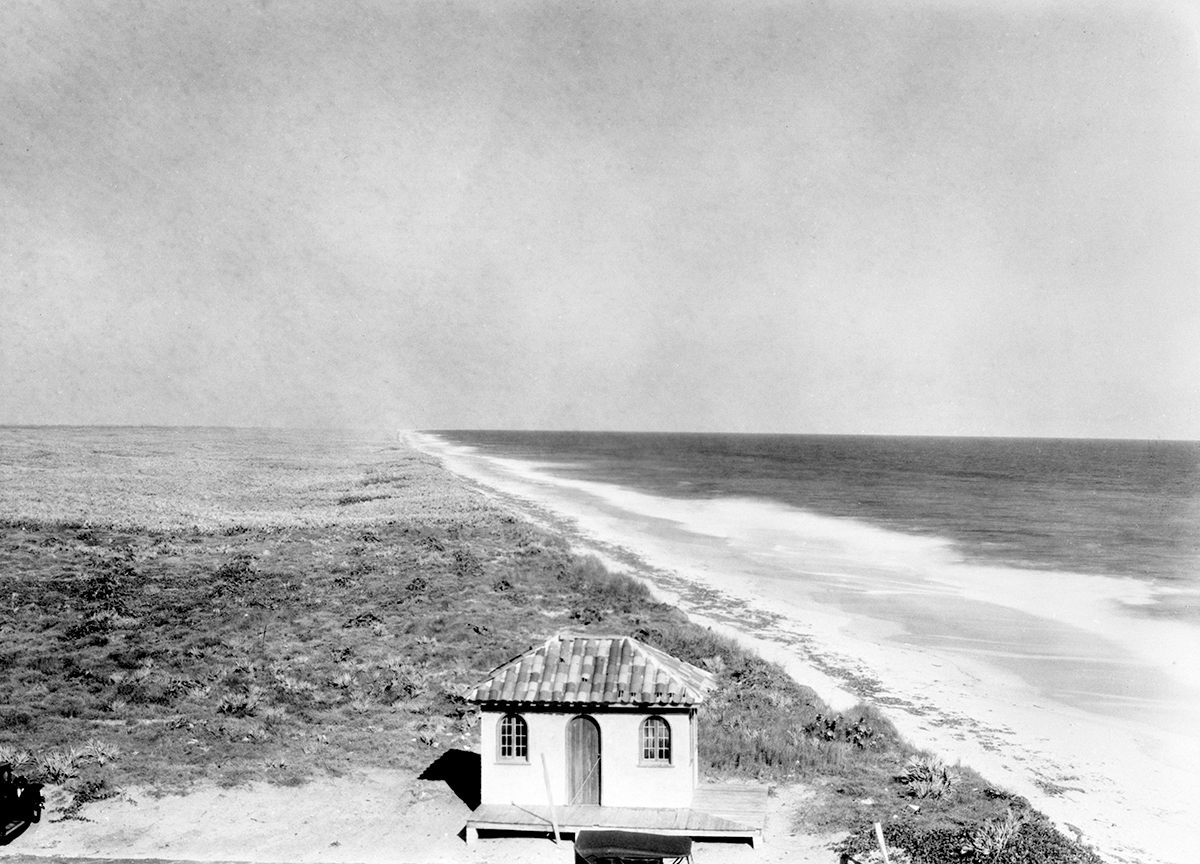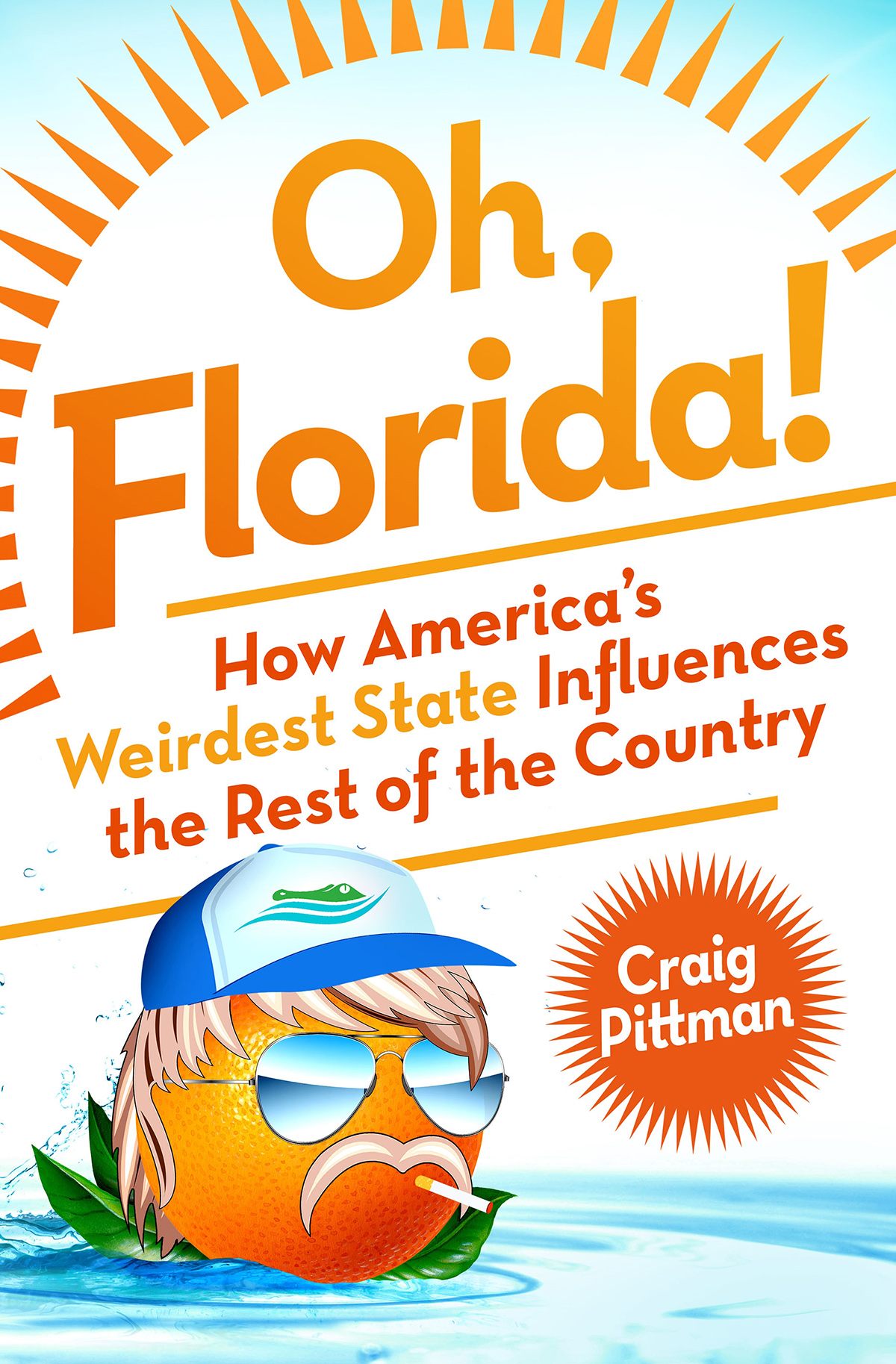How Florida Became the Temporary Center of Space Travel
Cape Canaveral’s fortunes rose with NASA, then fell.
Excerpted from Oh, Florida! How America’s Weirdest State Influences the Rest of the Country, published in July by St. Martin’s Press.
The Banana River Naval Air Station was built on the eve of World War II. The windswept promontory where it was located had once been the haunt of pirates and privateers. Just off its lonely coast is where the last naval battle of the Revolutionary War was fought
Not much had happened in Brevard County since then. The beaches of Merritt Island were difficult to reach by land, so few settlers tried. That meant that when the war came along, there were miles of undeveloped land for the military to put to use. Soon little old Banana River had added everything from Navy blimps to German prisoners of war to antisubmarine patrols to its mission.
When the war ended, Banana River was headed for a shutdown—until a cemetery in Mexico blew up.

Canova Beach in 1929. (Photo: NASA)
The U.S. Air Force had been testing missiles by firing them off from White Sands, New Mexico. One day, one strayed off course and obliterated a Juarez graveyard. Mexican officials complained, and the Air Force scrambled to find a new missile launch site.
Banana River was perfect. The weather was mostly good. Few people lived nearby. The site was close enough to the equator for zooming missiles to take advantage of Earth’s rotation for a little extra speed.
Banana River became the Joint Long Range Proving Ground, with the missiles rocketing over the Atlantic, far from any politically sensitive cemeteries. The government began condemning private land in the scattered seashore settlement north of Canova Beach to make more room for missile tests at what was now Patrick Air Force Base.
Then, in 1957, the Russians launched Sputnik. As that metal basketball orbited Earth for twenty-one days, Americans flipped. Suddenly everyone was asking why we let the Commies beat us to space.
Congress created a new agency to enable the United States to catch up. In 1958, the National Aeronautics and Space Administration was born, and it soon took over the old missile site and a lot more land nearby in an area that had for centuries been known by the alliterative name Cape Canaveral. Then JFK became president and vowed the United States would put a man on the moon by the end of the decade.

A twin-engine patrol bomber seaplane is hosed down at the Naval Air Station in Banana River, Florida, c. 1943. (Photo: NARA/520919)
In his 1867 novel From the Earth to the Moon, Jules Verne had correctly predicted the United States would shoot a moon rocket off from Florida because of its proximity to the equator, but he’d selected a spot near Tampa. He was off by more than one hundred miles from Cape Canaveral, where the homes of the remaining fishermen and farmers were now being torn down by space invaders intent on launching things into the wild blue yonder.
First came Explorer I, which lifted off from Cape Canaveral atop a modified V-2 rocket on January, 31, 1958. The Explorer did more than just circle Earth and stop, like Sputnik I. Its onboard scientific equipment documented the existence of radiation zones encircling Earth that were shaped by the planet’s magnetic field—the Van Allen radiation belts.
To stay ahead of the Russians, NASA needed scientists and engineers, fast. They came flooding into sleepy Brevard County from all over. There were buzz-cut defense contractors, stiff-backed military men, heavily accented Germans who had worked on the Nazis’ V2 rockets. NASA also needed construction crews to build its launch pads, gantries and, eventually, the largest one-story building in the world, the Vehicle Assembly Building—525 feet tall and 716 feet long—where the rockets were put together. To design its launch center, NASA hired architect Charles Luckman, who also designed Meyer Lansky and Bugsy Siegel’s famous Flamingo Hotel in Las Vegas.
Thanks to the influx of high-IQ rocket scientists and blue-collar builders, Brevard County’s population zoomed from 23,000 in 1950 to more than 111,000 in 1960. That’s more than a fivefold increase, and mostly in the last three years of the decade.

The chapel and theater of the Patrick Air Force Base. (Photo: US Government/Public Domain)
Suddenly Brevard needed more roads, schools, churches, stores, and everything else. Nobody had time to plan anything. Nobody thought about the long term. Crews threw together buildings as fast as possible and moved on to the next site.
So many new people had poured in that even with the locals renting out rooms, some recent arrivals wound up sleeping in their cars, or worse. When county work crews began installing a giant concrete pipe to bring potable water to the cape, they would knock off for the day and leave the pipe sitting by the roadside. In the morning, the crews would come back to work to discover people sleeping in the pipes.
Most NASA employees lived on the mainland, and the only way for them to get to work out at the cape was via a two-lane road with shoulders of soft sand. Anyone who veered off the pavement bogged down. When a NASA employee had a flat tire, he’d change it the middle of the road, stalling traffic behind him for miles. To file traffic reports, a local radio station employed a reporter on a mule because the mule could handle the sand.
The new arrivals didn’t always get along with the locals. They had such different backgrounds.

The first rocket is launched from Cape Canaveral on July 24, 1950. (Photo: NASA/Public Domain)
“Cape engineers thought they were smarter than everybody here. That filtered down to their kids,” one longtime local resident recalled years later. “They made a lot more money than the locals.”
The locals jacked up prices for tires, food, and other essentials, figuring the space cases could afford it. Meanwhile, a fresh contingent of hustlers moved into Brevard, looking to make a fast buck off the NASA crowd.
“The beach mushroomed and became sheathed in schlock,” writer Herbert Hiller reported. “Everything was built quick and short-term. Motels in Cocoa Beach and Titusville flashed neon rockets and dancing girls. Inside, sequined cuties danced and did more. Motel Row became Sin Strip … Saturnalia topped Saturn.”
Between the long hours at work at the Cape and the temptations offered by Sin Strip, Brevard soon had one of the highest divorce rates in the country. Then, when NASA brought its first class of astronauts to Florida, they treated Cape Canaveral as, in the words of Tom Wolfe, “a paradise of Flying and Drinking and Drinking and Driving.”

The Starlite Motel in Cocoa Beach, Florida. (Photo: Florida Memory)
Still, thanks to NASA, Florida’s reputation as a haven for gangsters faded, the racketeers replaced by rocketeers. With every news story about NASA, the state basked in the luster of Kennedy’s New Frontier. Titusville declared itself “the City of Tomorrow.” A new town was built named Satellite Beach. The region dubbed itself “the Space Coast.” Forget the past—Florida was all about the Fuuuuutuuuure!
When NASA started shooting astronauts into orbit—Alan Shepard, Scott Carpenter, John Glenn, and the rest—spectators showed up to watch. At first it was a few NASA employees and their families, but soon there were outsiders who brought binoculars, cameras, and a gaping curiosity. They were fascinated by the spectacle of a giant rocket roaring off the launch pad, with its occupants sitting in a little tin can on top, waiting to see if it would explode.

President Kennedy honoring astronaut John Glenn at Hangar S, in Cape Canaveral. (Photo: NASA/Public Domain)
While the space program kept everyone looking up, they should have been looking around. NASA’s impact was much broader than just giving the nation a new set of heroes and lending Florida a new tourist attraction. The science behind the space shots spun off everything from new techniques for cleaning up pollution to the spread of those automatic teller machines that Florida crooks are constantly trying to uproot and carry away.
Because President Kennedy had pledged to put a man on the moon, that was the space program’s main focus. As NASA geared up for the Apollo 11 launch to fulfill Kennedy’s pledge, its workforce at the cape peaked at 26,500 people. On July 19, 1969, the Saturn rocket carrying Neil Armstrong, Buzz Aldrin, and Michael Collins thundered into the sky for the rendezvous that Verne had predicted during the Civil War. To cover the biggest story in human history, seventeen hundred reporters from fifty-six countries had gathered at the cape. Meanwhile, jamming the beaches and highways were an estimated one million spectators, the largest crowd to ever witness a launch.

An aerial view of “missile row”, the launch complex for NASA and the US Air Force at Cape Canaveral, shown here in 1964. (Photo: NASA/Public Domain)
When Armstrong hopped down the ladder to the lunar surface and spoke his famous words about “one small step for man,” I was just a kid. My parents let me stay up late to watch the grainy images on our TV. I had trouble grasping how these pictures had been beamed from the moon outside our window straight down to our living room. Then the Apollo 11 astronauts came home to be greeted by President Nixon, his face frozen with that deathly rictus that showed he was trying, really trying, to grin.
After that, NASA’s sense of mission dropped off. Everyone in Brevard County found out what every coal miner and millworker in America knows: It’s not so great living in a company town, even if your company is out of this world. The whole town’s fortunes rise and fall on what that that one company does. A year after the moon landing, the workforce was cut to fifteen thousand employees. By 1975, it had fallen to a mere eight thousand.
Things got so bad in Brevard that some unemployed rocket scientists took jobs pumping gas. “Families left the area,” Florida Today reported. “People tell stories of some leaving their keys at their front door on the way out of town.”
Fortunately, in 1971, a big new employer opened right down the road from the Kennedy Space Center—one that redefined what a “City of Tomorrow” looked like.
From Oh, Florida: How America’s Weirdest State Influences the Rest of the Country by Craig Pittman. Copyright © 2016 by the author and reprinted with permission of St. Martin’s Press, LLC.













Follow us on Twitter to get the latest on the world's hidden wonders.
Like us on Facebook to get the latest on the world's hidden wonders.
Follow us on Twitter Like us on Facebook